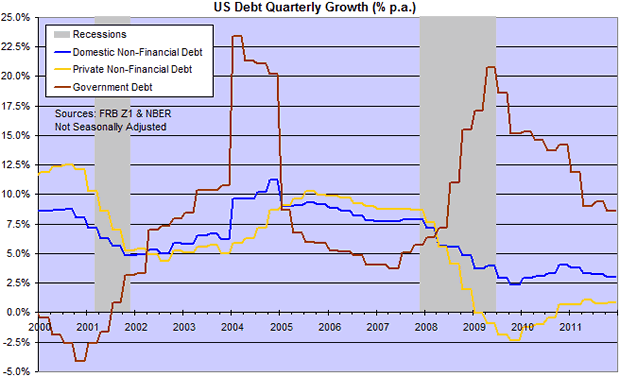US Public Debt Growing at Unsustainable Rate
Interest-Rates / US Debt Mar 21, 2012 - 10:08 AM GMTBy: Colin_Twiggs
 We often blame Fed monetary policy for the GFC, with interest rates at exceptionally low levels leading to "Greenspan's bubble." Treasury was just as culpable, however, with the massive 2004-2005 surge in public debt flooding the market with liquidity. The repeat in 2008-2011 was more justifiable: the spike in public debt was necessary to offset the sharp decline in private (non-financial) debt which would have caused a deflationary spiral. The effect was to smooth out the fall in total domestic debt (public and private) and create a relatively "soft" landing for the economy.
We often blame Fed monetary policy for the GFC, with interest rates at exceptionally low levels leading to "Greenspan's bubble." Treasury was just as culpable, however, with the massive 2004-2005 surge in public debt flooding the market with liquidity. The repeat in 2008-2011 was more justifiable: the spike in public debt was necessary to offset the sharp decline in private (non-financial) debt which would have caused a deflationary spiral. The effect was to smooth out the fall in total domestic debt (public and private) and create a relatively "soft" landing for the economy.
The financial sector is excluded from debt calculations as it largely acts as a conduit for other sectors.

Public debt growth is slowing but needs to fall further in order to keep the economy on a sustainable path. A rough rule of thumb is that public debt should grow no faster than GDP -- so that it does not outgrow the nation's ability to repay. With public debt growing at 8.6% and GDP at a nominal rate of 4.1%, Treasury's ability to repay -- and its credit rating -- is deteriorating. Reduction of public debt growth to a rate of no higher than 4.1% is necessary. Increases in tax collections as a percentage of GDP would alter this basic equation, but are highly unpopular and act as a disincentive to further GDP growth.

It should also be evident from the above chart that GDP contracts when the rate of domestic debt growth slows. If domestic debt ever had to contract (below zero growth), you can imagine the impact that it would have on GDP. That is a debt-deflation spiral and should be avoided at all costs. So, although we would all like to see a sharp reduction in debt levels, there are limitations on how quickly this can be achieved -- without smashing the economy into a brick wall.
We can also see that GDP growth for the past decade has been largely debt-fueled. Only recently has GDP growth surged above the growth rate of domestic debt, reflecting an increase in productivity. That is what we (not just the US) have to strive for: to widen the positive gap between GDP and domestic debt growth, while bringing public debt growth below the nominal rate of growth in GDP.
Reducing the rate of growth in public debt will not be easy, however, with private debt growing at a miserly 0.8% compared to domestic debt at 3.0%. The difference is made up by government debt, growing at a whopping 8.6%. Private capital expenditure, however, has in many cases been brought-forward to take advantage of accelerated tax write-offs and borrowing is likely to slow in the months ahead. Even worse is household debt which is contracting at an annual rate of 0.9%. So the medium-term outlook for private debt may be near-zero growth, which would cause further slowing of public debt growth to court another recession.

By Colin Twiggs
http://www.incrediblecharts.com
Colin Twiggs is a former investment banker and author of the popular Trading Diary and Goldstocksforex.com newsletters, with more than 140,000 subscribers. His specialty is blending fundamental analysis of the economy with technical analysis of stocks, markets, commodities and currencies. Focusing on the role of the Fed and banking credit as primary drivers of the economic cycle, Colin successfully forecast the October 2007 bear market -- eight months ahead of the sub-prime crisis.
These extracts from my trading diary are for educational purposes and should not be interpreted as investment or trading advice. Full terms and conditions can be found at Terms of Use .
© 2012 Copyright Colin Twiggs - All Rights Reserved Disclaimer: The above is a matter of opinion provided for general information purposes only and is not intended as investment advice. Information and analysis above are derived from sources and utilising methods believed to be reliable, but we cannot accept responsibility for any losses you may incur as a result of this analysis. Individuals should consult with their personal financial advisors.
© 2005-2022 http://www.MarketOracle.co.uk - The Market Oracle is a FREE Daily Financial Markets Analysis & Forecasting online publication.



